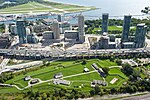Fort York

Fort York (French: Fort-York) is an early 19th-century military fortification in the Fort York neighbourhood of Toronto, Ontario, Canada. The fort was used to house members of the British and Canadian militaries, and to defend the entrance of the Toronto Harbour. The fort features stone-lined earthwork walls and eight historical buildings within them, including two blockhouses. The fort forms a part of Fort York National Historic Site, a 16.6-hectare (41-acre) site that includes the fort, Garrison Common, military cemeteries, and a visitor centre. The fort originated from a garrison established by John Graves Simcoe in 1793. Anglo-American tensions resulted in the fort to be further fortified, and designated as an official British Army post in 1798. The original fort was destroyed by American forces following the Battle of York in April 1813. Work to rebuild the fort began later in 1813 over the remains of the old fort, and was completed in 1815. The rebuilt fort served as a military hospital for the remainder of the War of 1812, although it briefly saw action against an American naval vessel in August 1814. After the war, the fort continued to see use by the British Army and the Canadian militia; even after newer fortifications were erected west of Fort York in the 1840s. In 1870, the property was formally transferred to the Canadian militia. The municipal government assumed ownership of the fort in 1909, although the Canadian military continued to make use of the fort until the end of the Second World War. The fort and the surrounding area was designated as a National Historic Site of Canada in 1923. The fort was restored to its early-19th century configuration in 1934, and reopened as a museum on the War of 1812 and military life in 19th century Canada.
Excerpt from the Wikipedia article Fort York (License: CC BY-SA 3.0, Authors, Images).Fort York
Fort York Boulevard, Toronto
Geographical coordinates (GPS) Address Website External links Nearby Places Show on map
Geographical coordinates (GPS)
| Latitude | Longitude |
|---|---|
| N 43.639027777778 ° | E -79.403333333333 ° |
Address
Fort York
Fort York Boulevard 250
M5V 0C8 Toronto
Ontario, Canada
Open on Google Maps










